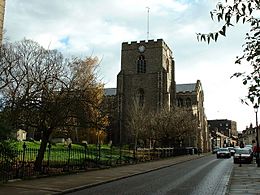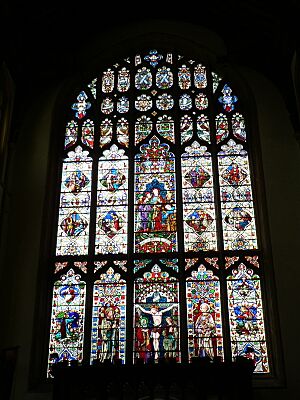St Mary's Church, Bury St Edmunds facts for kids
Quick facts for kids St Mary's Church, Bury St. Edmunds |
|
|---|---|

St Mary's Bury St Edmunds
|
|
| Country | United Kingdom |
| Denomination | Church of England |
| Website | www.wearechurch.net |
| History | |
| Founded | 11th Century |
| Dedication | Assumption of the Blessed Virgin Mary |
| Architecture | |
| Style | Decorated |
| Years built | 1424–1446 |
| Specifications | |
| Length | 213ft |
| Bells | 8 |
| Tenor bell weight | 27cwt |
| Administration | |
| Parish | St Mary with St Peter, Bury St Edmunds |
| Deanery | Thingoe |
| Diocese | Diocese of St Edmundsbury and Ipswich |
| Province | Canterbury |
St Mary's Church in Bury St Edmunds is a very important church for the town. It's one of the biggest parish churches in England. People say it has the second longest aisle and the largest West Window of any parish church in the country. It used to be part of the Abbey and was one of three big churches in Bury St Edmunds. The other two were St James (now St Edmundsbury Cathedral) and St Margaret's (which is no longer there).
Contents
A Look at St Mary's Church History
The church you see today is not the first one built here. The very first church was started in the 7th century by King Sigeberht. Later, around 1125, Abbot Anselm built a new church. This was to replace an older St Mary's church that was taken down to make room for the Abbey.
Building the Church You See Today
None of the Norman church from Abbot Anselm's time remains. The oldest part of the current building is the chancel, which was built around 1290. This part shows the Decorated Gothic style.
Between the 14th and 16th centuries, the church had a big makeover. During this time, the main part of the church (the nave), its side aisles, and the tower were built.
Mary Tudor's Burial Place
During the 16th century, Mary Tudor was buried here. She was the favorite sister of Henry VIII. Her tomb is in the sanctuary, near the Lord's table. It's important to know that the church is named after Mary, the mother of Jesus, not Mary Tudor. Some people sometimes get this mixed up.
Donations and Changes Over Time
In the 16th century, two wealthy local people, John Notyngham and Jankyn Smyth, gave a lot of money to the church. This money helped build the north and south quire aisles. These are now called the Lady Chapel and the Royal Anglian (or former Suffolk Regimental) chapel. They also helped build two chantry chapels and two porches.
The south porch was removed in the 1830s when the church was restored. A new chapel, St Wolstan's, was added on the north-west side. Since then, the inside of the church has been updated with modern things.
What Makes St Mary's Special?
A famous author named Simon Jenkins gave St Mary's Church three stars in his 1999 book England's Thousand Best Churches. He wrote that the inside of the church has one of the biggest and most exciting naves in the country. The nave is the long central part of the church.
He also mentioned the amazing hammerbeam roof. This roof has eleven pairs of angels watching over the space below. There are also smaller angels, saints, and other figures, 42 in total. The roof also has a frieze with medieval animals like dragons, unicorns, birds, and fish.
Music at St Mary's Church
St Mary's Church has a long history of music.
The Traditional Choir
The church has a traditional Anglican choir with boys and gentlemen. This choir has been around since at least 1354. There are old records talking about singers and "childs with a surplys" (children in choir robes). This tradition continued even during tough times for churches.
The choir has traveled to many countries, including Spain, Turkey, and Germany. They have also sung special evening services called evensongs at famous places like Canterbury Cathedral and St Paul's Cathedral. The choir is part of the RSCM (Royal School of Church Music).
Other Choirs
In 2010, St Mary's Ladies' Choir was started. Then, in 2015, the Girls' Choir began. These choirs are separate from the main Church Choir. However, they all sing together for big services like Easter, Harvest, Advent, and Christmas.
The Church Organ
There has been an organ at St Mary's since at least 1467. Old records show payments to "ye pleyers at ye orgenys" (the organ players).
The main organ is a very large instrument with four keyboards and 79 different sounds. It was first built in 1825 by John Gray. It has been rebuilt and made bigger several times since then by different builders. The latest changes were in 1988, which included a mobile console (the part where the organist sits).
There is also a smaller organ in the Suffolk Regimental Chapel. This organ is good for playing quieter music.
Past Organists
Here are some of the people who have played the organ at St Mary's Church:
- Ralph Guest (1796–1822)
- Robert Nunn (1822–1863)
- Thomas Bentick Richardson (1864–1893)
- Matthew Kingston (1893–1896)
- George William Boutell (1897–1909)
- Edward Percy Hallam (1909–1937)
- Clifton Cecil Day (1937–1942)
- Dr Adcock (1942–1948)
- Norman Holdford Jones (1948–1969)
- John Fear (1969–1980)
- David Ivory (1980–1982)
- Peter Tryon (1983–2015)
- Adrian Marple (2015–2018)
Notable People Buried at St Mary's
Many important people have been buried at St Mary's Church over the centuries. Here are a few:
- Nicholas Clagett the Elder (died 1662), a Puritan church leader.
- Sir William Carew (died 1501), a knight honored by King Henry VII after a battle.
- Robert Drury (died 1536), who was the Speaker of the House of Commons.
- George Kirbye (died 1634), a famous composer of madrigals (a type of song).
- Peter Gedge (died 1818), who started the Bury and Norwich Post newspaper.
- John Reeve (died 1540), who was the last abbot of Bury St Edmunds Abbey.


